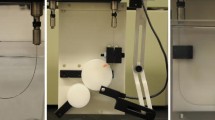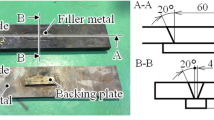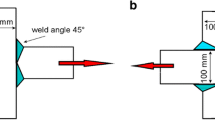Abstract
Zero mean strain rotating beam fatigue testing has become the standard for comparing the fatigue properties of Nitinol wire. Most commercially available equipment consists of either a two-chuck or a chuck and bushing system, where the wire length and center-to-center axis distance determine the maximum strain on the wire. For the two-chuck system, the samples are constrained at either end of the wire, and both chucks are driven at the same speed. For the chuck and bushing system, the sample is constrained at one end in a chuck and rides freely in a bushing at the other end. These equivalent systems will both be herein referred to as Chuck-to-Chuck systems. An alternate system uses a machined test block with a specific radius to guide the wire at a known strain during testing. In either system, the test parts can be immersed in a temperature-controlled fluid bath to eliminate any heating effect created in the specimen due to dissipative processes during cyclic loading (cyclic stress induced the formation of martensite) Wagner et al. (Mater. Sci. Eng. A, 378, p 105–109, 1). This study will compare the results of the same starting material tested with each system to determine if the test system differences affect the final results. The advantages and disadvantages of each system will be highlighted and compared. The factors compared will include ease of setup, operator skill level required, consistency of strain measurement, equipment test limits, and data recovery and analysis. Also, the effect of test speed on the test results for each system will be investigated.
Similar content being viewed by others
Avoid common mistakes on your manuscript.
Sample Preparation
All of the samples for this study were produced from one lot of 0.53-mm-diameter amber oxide wire (Ti-55.8/55.9 wt.%Ni) which was drawn to yield approximately 45% cold work on the final material. All of test samples were shape set straight using the same heat treatment process: tooling, time, temperature, and heat source (Ref 1). After the heat treatment, the parts were cleaned ultrasonically in isopropyl alcohol (IPA) and water solution with no additional chemical processing or surface treatment.
Chuck-to-Chuck Method Setup
The setup of the Chuck-to-Chuck method starts with the calculations for determining the bending radius to give the required strain. The radius-to-strain relationship is defined by \( \varepsilon \, = \frac{r}{R} { \times }{ 1}00\% \), where ε is the strain, r the radius of the wire, and R is the radius of curvature to the neutral axis of the wire (Ref 2). Next, the wire length and Chuck-to-Chuck distance required to yield the desired strain are calculated. These calculations do not include the additional length of wire that is inserted into each chuck. The curvature of the wire will not be a full radius but rather the ellipse-like shape as represented in Fig. 1 and defined by the simplified calculations as shown in Fig. 1. These calculations were developed by Clarke and Bates of Hunter Spring Company ca. 1940 (Ref 3). An actual image of a sample ready for test is shown in Fig. 2. These calculations will give the minimum radius of the wire constrained only at the chucks. This minimum radius occurs only at the apex of the ellipse-like shape. Therefore, the design strain precisely occurs only at the apex of the ellipse-like shape.
The Clarke and Bates calculations were developed for standard materials yet have been widely adopted for use with pseudoelastic materials. The model was not designed to simulate the pseudoelastic plateau effect. Additionally, for Nitinol in pseudoelastic bending, the neutral axis must shift toward the compressive side to balance the distribution of tensile and compressive stresses in the cross section (Ref 4). Therefore, for strains above 1% which approximately correspond to the start of the pseudoelastic upper plateau, the Clark and Bates calculations will be less precise than when used below 1% strain on the elastic modulus portion of the stress-strain curve. This small loss of precision due to the combined effects listed above has largely been ignored or treated as inconsequential by industry.
Machined Block Method Setup
The setup of the machined block method starts with the calculations for determining the bending radius to give the required strain. The radius-to-strain relationship is defined by \( \varepsilon \, = \frac{r}{R} { \times }{ 1}00\% \), where ε is the strain, r the radius of the wire, and R is the radius of curvature to the neutral axis of the wire (Ref 2). Next, a groove is machined into the polymer test block with a suitable depth and a width to provide sufficient clearance for the wire diameter being tested to reduce any effects of friction on the test sample (Ref 5). A test block with a specimen installed is shown in Fig. 3. A clear polymer cover is then installed on the block to retain the sample during the test. The strain on the test sample is precisely the design strain calculated using the formula above for the entire 90° of included arc length of the sample. A small marker is attached to the free end of the wire to register cycles to failure using a laser counting system.
As mentioned above, for Nitinol in pseudoelastic bending, the neutral axis must shift toward the compressive side to balance the distribution of tensile and compressive stresses in the cross section (Ref 4). Therefore, for strains above 1% which approximately correspond to the start of the pseudoelastic upper plateau, these simplified calculations for the uniform stress in this test method will also be less precise than when used below 1% strain on the elastic modulus portion of the stress-strain curve. This small loss of precision will be ignored for this research as this is the industry standard approach.
Chuck-to-Chuck Method Operation
For the style of Chuck-to-Chuck tester used in this research and shown in Fig. 4, Chuck-to-Chuck spacing and test speed are entered through the front panel. The style of break detection sensor on this machine consists of two brass plates on an adjustable arm as shown in Fig. 5. The plates are positioned so that the edge of the broken sample will contact both plates and send a signal to the controller to stop the test. The sample is immersed in the temperature-controlled circulating water bath and run to failure or run out. This equipment can run one sample at a time at test speeds of 20 to 10,000 RPM.
Machined Block Method Operation
For the machined block tester used in this research and shown in Fig. 6 and 7, the strain is controlled by the test block used and the speed is set on a motor control. Break detection is accomplished by a laser counter sensing the rotation of the marker on the free end of the test sample. The sample is immersed in the temperature-controlled circulating water bath and run to failure or run out. The equipment is manually stopped by the operator when all samples fail or run out is reached. This equipment can run ten samples at a time at test speeds of 100 to 1500 RPM.
Chuck-to-Chuck Method Data Recovery and Analysis
After test, the length of each wire section must be precisely measured. If the wire is broken at a spot other than the center of the test specimen as is shown in Fig. 8, then the actual strain at the break must be calculated using a correction factor based on the location of the break. Table 1 shows selected data from the correction factor table developed by Clarke and Bates of Hunter Spring Company ca. 1940 (Ref 3). Sample calculations based on the formulas shown in Fig. 1 are shown below. The wire measurements post fracture do not include the additional lengths of wire that are inserted into the chucks. Only the free unsupported lengths are included in these calculations:
Wire diameter: 0.53 mm
Design strain: 1.00%
Using Table 1, strain correction factor is approximately 3.4%
Figure 9 and 10 show SEM images of a sample after test. The sample fracture edges contact the break sensor to stop the test and register the cycles to failure. It takes a finite amount of time for the machine to register the break and come to a complete stop. In that time, the edge of the fracture surface gets slightly burnished and rolled over. This can make detection of the fracture initiation point difficult. An alternate break detector shown in Fig. 11 contacts the wire away from the break edge and eliminates this problem.
Machined Block Method Data Recovery and Analysis
Any break within the 90° of the included arc length will be precisely at the design strain (Ref 5) (Fig. 12). The laser counter will stop counting as soon as it detects no motion in the marker attached to the free end of the wire. The remainder of the wire that is attached to the driving chuck will continue to rotate until the test is suspended. Because of this, it is possible to see multiple breaks in one length of wire as shown in Fig. 13. Only the first break at the free end of the wire occurs at the recorded number of cycles to failure.
Because of the energy stored in the strained wire, the pieces of the broken wire usually spring apart immediately upon fracture. However, a small number (approximately 5 to 10%) of the wire samples will remain close enough to rub face to face for several revolutions. This can lead to face burnishing of the fracture surface as shown in Fig. 14 and 15. This burnishing can ruin any chance at fracture analysis but only occurs in a small percentage of the fractures.
Results
The results of the fatigue testing comparison are shown below. Table 2 includes all the individual data. Figure 16, 17, and 18 are plots of the average values. For the plots, each data point represents the average of five samples for each strain level and test condition. The data show very similar results for both test methods and all test speeds when tested at or below 1.0% strain. At strains above 1.0%, there is significantly greater variation in results.
The similar results at or below 1% strain demonstrate that the test methods can provide equivalent data. The water-lubricated test blocks in the machined block method do not add significant friction to the test sample to affect the results. The soft polymer blocks do not polish the samples or smooth the sample surface during test. Therefore, they do not artificially increase the resulting fatigue life.
For the individual test methods, below 2% strain, there was no difference in results based on test speed. This demonstrates that for each method, the temperature-controlled bath effectively eliminates any heating effect created in the specimen due to dissipative processes during cyclic loading (cyclic stress induced the formation of martensite) (Ref 6). This allows faster test speeds without compromising the results.
At 2.5% strain, which is the highest strain tested for this research, there is observed the most variation. As fatigue life is a stochastically controlled phenomenon, this is not unexpected. Experience shows that with more data points, the data will normalize even at 2.5% or higher strain.
As noted above, the Clark and Bates calculations are less precise for strains above 1%. They were modeled on standard materials without a pseudoelastic plateau. The slight deviation of actual stresses from the design conditions could contribute partially to the reduced fatigue life for the Chuck-to-Chuck method in the plateau region.
This single significant difference determined in this research is the increased fatigue life by the machined block method in the 1 to 2% strain region. At greater than 1% strain, the test sample is loaded on the pseudoelastic plateau. For the machined block method, the entire 90° of the included arc length of the sample is loaded precisely at the same plateau strain and is constrained from any vibration by the test block. For the Chuck-to-Chuck method, only the apex of the test sample will be at the design plateau strain. Because the sample is unrestrained, vibration can cause the high strain apex to “walk” along the test sample as the testing proceeds. This leads to a non-homogeneous stress-induced martensite distribution and therefore a moving area of stress concentration (Ref 4). See Fig. 19 for an image of a high strain sample loaded on the pseudoelastic plateau where the apex of the ellipse has “walked” off center. Even with an external vibration damping device, the high strain apex can “walk” off center. This strain variation can lead to premature fatigue failure (Ref 7).
Summary
Each of the fatigue test methods evaluated here has advantages and disadvantages. The Chuck-to-Chuck method requires no hard tooling and can be run at very high speeds, but precise strain measurement and consistency at high strain can be problematic. The machined block method can test 10 samples at a time with very precise strain control but is limited in test speed and requires machined tooling for each diameter/strain combination. Table 3 summarizes the advantages and disadvantages of the two methods.
The decision on which method is better is dependent on the application. For example, for high speed testing with a variety of wire diameters and strain levels, the Chuck-to-Chuck method offers the most flexibility and does not require manufacture of hard tooling and therefore is the obvious choice. A typical application would be screening large numbers of variables to determine their effect on fatigue life.
However, for testing large numbers of samples having the same diameter/strain level or for applications where the precise strain at fracture must be controlled, the machined block method is clearly superior. A typical application would be a pass/fail quality requirement where 100 samples must exceed 10,000 cycles at 1.2% strain for acceptance of a wire lot.
References
A. Pelton, J. DiCello, S. Miyazaki, “Optimization of Processing and Properties of Medical-Grade Nitinol Wire”, SMST-2000 Proceedings of the International Conference on Shape Memory and Superelastic Technologies, S.M. Russel and Alan R. Pelton, Eds., Pacific Grove, International Organization on SMST, California, 2001, p 361–374
D. Norwich and A. Fasching, “A Study on the Effect of Diameter on the Fatigue Properties of NiTi Wire”, SMST-2008 Proceedings of the International Conference on Shape Memory and Superelastic Technologies, A. Tuissi, M. Mitchell and J. San Juan, Eds., Stresa, Italy, 2009, p 558–562
P.C. Clarke and A.C. Bates, Hunter Spring Company ca. 1940
B. Reedlunn, C. Churchill, E. Nelson, J. Shaw, and S. Daly, Tension, Compression, and Bending of Superelastic Shape Memory Tubes, J. Mech. Phys. Solids, 2014, 63, p 506–537
M. Polinsky, D. Norwich, and M. Wu, “A Study on the Effects of Surface Modifications and Processing on the Fatigue Properties of NiTi Wire”, SMST-2006 Proceedings of the International Conference on Shape Memory and Superelastic Technologies, B. Berg, M. Mitchell, and J. Proft, Eds., Pacific Grove, CA, 2008 p 1–17
M. Wagner, T. Sawaguchi, G. Kaustrater, D. Hoffken, and G. Eggeler, Structural Fatigue of Pseudoelastic NiTi Shape Memory Wires, Mater. Sci. Eng. A, 2004, 378, p 105–109
Z. Lin, K. Pike, M. Schlun, A. Zipse, and J. Draper, “Nitinol Fatigue Life for Variable Strain Amplitude Fatigue”, SMST-2011 Proceedings of the International Conference on Shape Memory and Superelastic Technologies, M. Mitchell, Ed., Hong Kong, China, 2012 p 2628–2632
Acknowledgements
I would like to thank Karen Duran and Dale Mandanici of Memry Corporation for their tireless efforts in testing countless iterations of samples for this and many other research studies. Their assistance with the ever changing requests of the author is greatly appreciated.
Author information
Authors and Affiliations
Corresponding author
Additional information
This article is an invited paper selected from presentations at the International Conference on Shape Memory and Superelastic Technologies 2013, held in May 20-24, 2013, in Prague, Czech Republic, and has been expanded from the original presentation.
Rights and permissions
About this article
Cite this article
Norwich, D.W. A Comparison of Zero Mean Strain Rotating Beam Fatigue Test Methods for Nitinol Wire. J. of Materi Eng and Perform 23, 2515–2522 (2014). https://doi.org/10.1007/s11665-014-0939-2
Received:
Revised:
Published:
Issue Date:
DOI: https://doi.org/10.1007/s11665-014-0939-2























